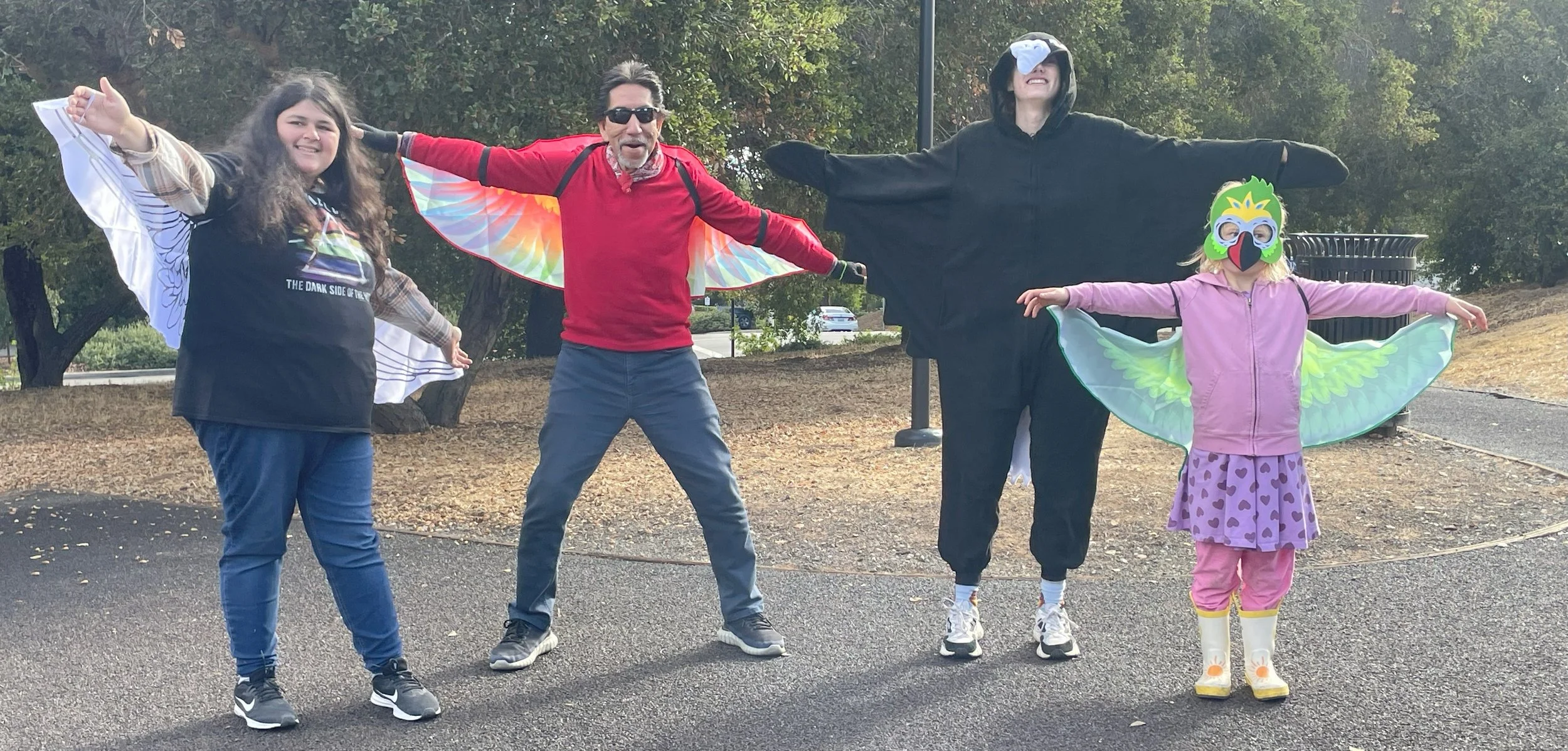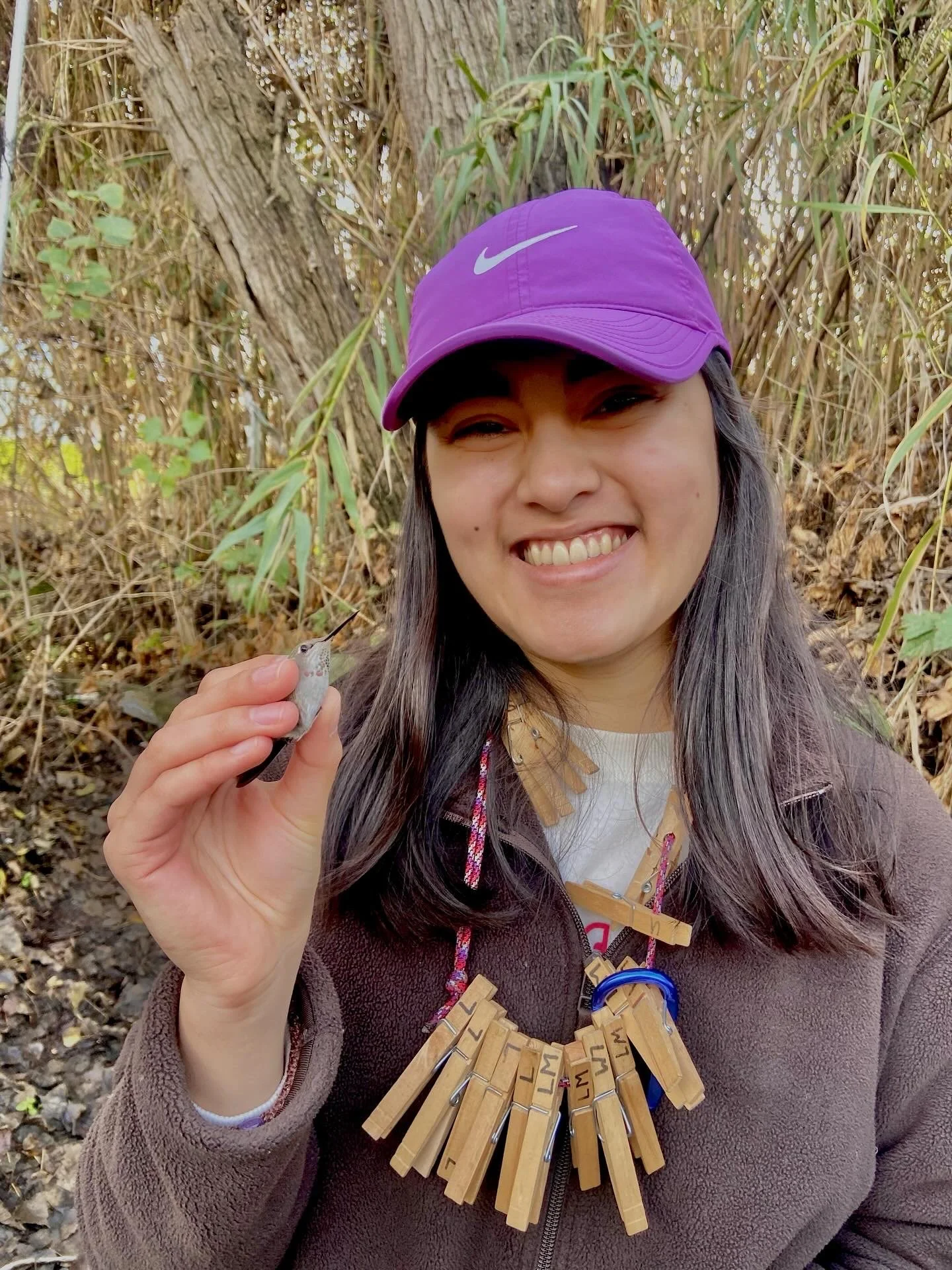
Flying into fall: a bird-themed BioBlitz!
by Maya Xu
“Oh, this is going to be perfect!”
On a chilly Friday afternoon, Marty and I stood in the middle of the Dirzo lab, looking like two birds of a feather. Well, maybe not exactly the same - Marty was decked out in a full-body penguin suit that just passed for a Pileated Woodpecker, while I was strutting around the room sporting a feathered green mask and fluttering a pair of bright green wings.
Nope, this wasn’t for a Halloween party. Marty and I were road-testing the costumes we’d carefully curated for the audience of our bird-themed BioBlitz. We’d planned the event together with our advisor and PI of the NSF-funded SOAR (San Francisco Bay Research Coordination Network for Student Opportunities in Avian Research to Enhance STEM Education) program, Dr. Rodolfo Dirzo. A typical BioBlitz means a day of counting up every species you can find in an area. In our case, this was the Lagunita Conservation Area, a former-lake-turned-marshland that provides critical habitat for animals like the endangered California tiger salamander, a seemingly endless stream of ground squirrels, and of course, plenty of birds. It’s a favorite spot of the Stanford Birdwatching Club (SBC) for our quarterly kick-off events, where we’ll usually host a casual morning walk around the area.
But our BioBlitz was slightly different. We did start the day with some birding, but in keeping with one of SOAR's main goals of educating diverse audiences about birds, the second half of our day was devoted to avian education. Rodolfo, Marty and I co-instruct Stanford's ornithology class (BIO 121/221) in spring, so we took activities that we’d developed for our students and adapted them for an audience drawn from multiple age groups. While we’d originally planned for a group largely made of high schoolers and undergraduates, we very quickly realized after sending out our interest form to the Bay Area community that there’d be plenty of younger kids (and their parents!) at the event too. It was up to us to make a gameplan that had enough bird facts, and of course, plenty of silliness to go around.
At 8am on November 2nd, Marty and I were waiting at the Lagunita barbecue pit for our first bird-lovers (or future bird nerds) to arrive. The air was crisp, and already filled with the calls of foraging Western Bluebirds in flight and calling Zonotrichia sparrows on the ground. The group ended up being roughly 40 people, from knee-high toddlers from the Hillbrook School to a contingent of UC Santa Cruz students from their campus chapter of SEEDS (Strategies for Ecology Education, Diversity and Sustainability), who had rideshared the 1.5 hours to get to Lagunita.
After some quick introductions, we all split up for some semi-competitive birding. One intrepid group was led by Marty and SBC club president Noah Eckman circling Lagunita one way, while Rodolfo (clad in a gorgeous scarlet macaw costume) and I led the others.
Our group was in high spirits as we started out, and the kids got especially excited when I told them we were competing to count more birds than the other groups. Most of my team were novice birders, and everything was new and exciting for them, from the mild-mannered juncos scuffling for bugs to the raggedy-winged turkey vultures that sometimes swooped into view, setting off a frenzy of people who thought they’d seen a hawk instead. It felt like every minute I heard another voice pipe up, “Maya, I found a bird!,” and one of the kids actually found a beautiful red-shouldered hawk secondary feather, which we passed around while I gave the group a mini-lecture about feather and flight mechanics. Parents and students alike were working together to identify all of their new winged friends, united by a newfound camaraderie through birding.
A few of our younger participants posing with Rodolfo, all decked out in bird costumes! Photograph by the author.
Afterwards, we took some time for “trophication” (the always fun activity of eating). We’d put in an order for a gigantic stash from Trader Joe’s, which I lugged up the hill from my dorm to Lagunita on a shaky trolley. I was still shocked at how fast everything went (especially the green grapes!). While everyone worked on their snacks, we pulled out some taxidermy (mounted animal specimens) that I’d borrowed from the Palo Alto EcoCenter, where I used to volunteer as an EcoDocent. The kids’ eyes went wide as we handed around entire stuffed Ring-necked Pheasants and propped up two beautifully mounted Mallards.
“Are they real birds?” one of the kids whispered to me, reaching out with a hesitant hand.
“Yep!” I replied. “They’re being used for science now. You can touch them gently if you want.” Most of the kids immediately shook their heads. But, just like the ones that used to visit the EcoCenter, it only took a few more minutes of gentle encouragement before they were running their fingers over the soft feathers. Even though we weren’t able to show them any live birds in the hand, it was still incredible to watch the wonder that spread over their faces as many got their first intimate look at the closest living relatives to the dinosaurs.
However, the best part of the day was definitely the activities we’d planned post-snacktime. After a spirited round of bird trivia, which ranged from Lagunita-specific questions to larger-scale debates about avian ecosystem services, it was time to break out the costumes for “Birds in Flight.” Of course, the smaller kids were completely delighted, with one of them zipping back and forth at a speed that almost matched a real hummingbird. The older students were a little more reluctant to flap for the camera, but the day ended in laughs and cheers as we learned about different flight patterns from the superb acting of our volunteers.
Everyone was all smiles when they left Lagunita, with some families lingering a little longer to chat about their favorite sightings, while kids showed off feathers they’d found or mimicked bird calls they’d learned. As folks went on their ways to open up new eBird accounts, make plans to join local Audubon society field trips, and all the rest, it felt like we’d managed to inspire many new friends with these amazing animals, having a blast with beautiful birds and a fantastic group of people. What better way to spend a Saturday morning?
We can’t wait to bring another batch of students SOARing into Lake Lag or another bird-friendly venue next fall!
Maya Xu is a bird lover who recently earned her B.S.H. in Biology at Stanford (Class of 2025). She is currently a coterminal masters student in Biology, a member of Professor Rodolfo Dirzo's lab, a docent at Jasper Ridge Biological Preserve ('Ootchamin 'Ooyakma), and a SOAR intern.




